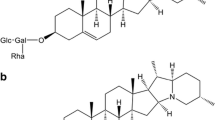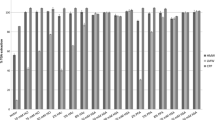Abstract
A new procedure has been developed to extract gram quantities of glycoalkaloids from freeze-dried potato blossoms. The per cent recovery is 65–70%, yielding a mixed glycoalkaloid product that is greater than 90% glycoalkaloids. This method is very simple and rapid with completion in only two days. This new methodology will be very useful in entomological and toxicological research where large amounts of these glycoalkaloids are utilized.
Resumen
Se desarrolló un nuevo procedimiento para extraer cantidades gramo de glicoalcaloides a partir de flores liofilizadas de papa. El porcentaje de recuperación es de 65–70%, lo que produce un producto mezclado de glicoalcaloide que contiene más de 90% de glicoalcaloides. Este método es muy simple y rápido y se termina en sólo dos días. Este nuevo método será muy útil en la investigación entomológica y toxológica en que se utilizan grandes cantidades de estos glicoalcaloides.
Similar content being viewed by others
Literature Cited
Achterberg, C. L., D. M. Clauson, J. A. Blease and E. S. Barden 1979. A new procedure for the mass extraction and collection of potato glycoalkaloids. Am Potato J 56:145–148.
Allen, R. J., R. J. Marlar, G. F. Chesney, J. P. Helgeson, A. Kelman, K. G. Weckel, E. Traisman and J. W. White, Jr. 1977. Teratogenicity studies on late blighted potatoes in nonhuman primates (Macaca mulatta andSaghinus labiatus). Teratology 15:17–24.
Bushway, R. J., E. S. Barden, A.W. Bushway and A. A. Bushway. 1979. Highperformance liquid Chromatographic separation of potato glycoalkaloids. J Chromatogr 178:533–541.
Hanson, A. A. 1925. Two fatal cases of potato poisoning. Science 61:340–341.
Keeler, R. F., D. Brown, D. R. Douglas, G. F. Stallknecht and S. Young. 1976. Teratogenicity of theSolanum alkaloid Solasodine and of “Kennebec” potato sprouts in hamsters. Bull Environ Contain Toxicol 15:522–524.
Keeler, R. F., D. R. Douglas and G. F. Stallknecht 1975. The testing of blighted, aged and control Russet Burbank potato tuber preparation for ability to produce spina bifida and anencephaly in rats, rabbits, hamsters and mice. Am Potato J 52:125–132.
Mun, A. M., E. S. Barden, J. M. Wilson and J. M. Hogan 1975. Teratogenetic effects in early chick embryos of solanine and glycoalkaloids from potatoes infected with late blight,Phytophthora infestayns. Teratology 11:73–77.
Renwick, J. H. 1972. Hypothesis. Anencephaly and spina bifida are usually preventable by avoidance of a specific but unidentified substance in certain potato tubers. Br J Prev Soc Med 26:67–88.
Willimott, S. G. 1933. An investigation of solanine poisoning. The Analyst. 58:431–439.
Wilson, G. S. 1959. A small outbreak of solanine poisoning. Mon Bull Minist Health Public Health Lab Serv Directed Med Res Counc 18:207–210.
Author information
Authors and Affiliations
Rights and permissions
About this article
Cite this article
Bushway, R.J., Barden, E.S., Bushway, A.W. et al. The mass extraction of potato glycoalkaloids from blossoms. American Potato Journal 57, 175–180 (1980). https://doi.org/10.1007/BF02853869
Received:
Issue Date:
DOI: https://doi.org/10.1007/BF02853869




